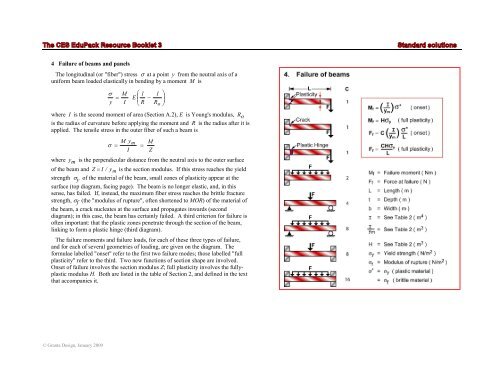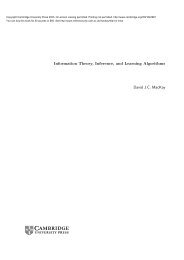Useful Approximate Solutions for Standard ... - MAELabs UCSD
Useful Approximate Solutions for Standard ... - MAELabs UCSD
Useful Approximate Solutions for Standard ... - MAELabs UCSD
You also want an ePaper? Increase the reach of your titles
YUMPU automatically turns print PDFs into web optimized ePapers that Google loves.
4 Failure of beams and panels<br />
The longitudinal (or "fiber") stress σ at a point y from the neutral axis of a<br />
uni<strong>for</strong>m beam loaded elastically in bending by a moment M is<br />
© Granta Design, January 2009<br />
σ<br />
y<br />
=<br />
M<br />
I<br />
⎛ 1<br />
E ⎜<br />
⎝ R<br />
−<br />
where I is the second moment of area (Section A.2), E is Young's modulus, R o<br />
is the radius of curvature be<strong>for</strong>e applying the moment and R is the radius after it is<br />
applied. The tensile stress in the outer fiber of such a beam is<br />
σ =<br />
M ym<br />
=<br />
I<br />
M<br />
Z<br />
where y m is the perpendicular distance from the neutral axis to the outer surface<br />
of the beam and m y / I Z = is the section modulus. If this stress reaches the yield<br />
strength σy of the material of the beam, small zones of plasticity appear at the<br />
surface (top diagram, facing page). The beam is no longer elastic, and, in this<br />
sense, has failed. If, instead, the maximum fiber stress reaches the brittle fracture<br />
strength, σ f (the "modulus of rupture", often shortened to MOR) of the material of<br />
the beam, a crack nucleates at the surface and propagates inwards (second<br />
diagram); in this case, the beam has certainly failed. A third criterion <strong>for</strong> failure is<br />
often important: that the plastic zones penetrate through the section of the beam,<br />
linking to <strong>for</strong>m a plastic hinge (third diagram).<br />
The failure moments and failure loads, <strong>for</strong> each of these three types of failure,<br />
and <strong>for</strong> each of several geometries of loading, are given on the diagram. The<br />
<strong>for</strong>mulae labelled "onset" refer to the first two failure modes; those labelled "full<br />
plasticity" refer to the third. Two new functions of section shape are involved.<br />
Onset of failure involves the section modulus Z; full plasticity involves the fullyplastic<br />
modulus H. Both are listed in the table of Section 2, and defined in the text<br />
that accompanies it.<br />
1<br />
Ro<br />
⎞<br />
⎟<br />
⎠
















